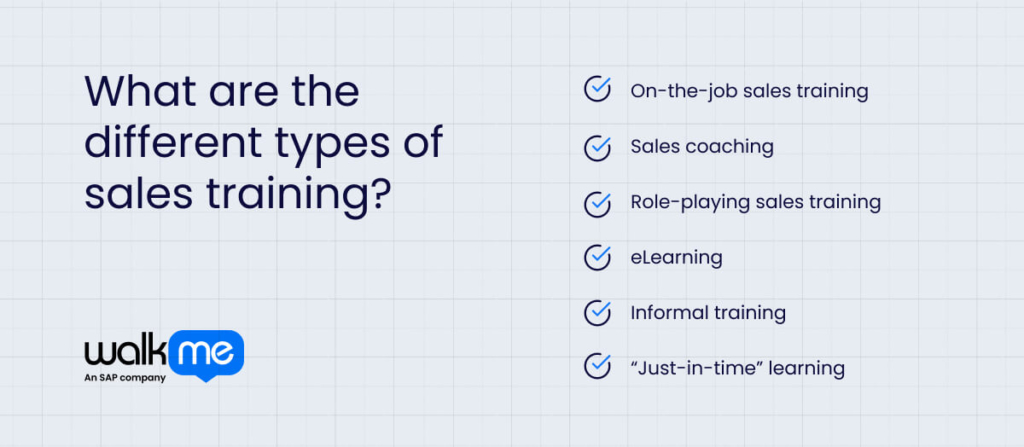In today’s information-rich world, sales professionals remain essential in B2B and B2C environments. They help consumers navigate complex product landscapes and digital experiences by providing personalized guidance and human connection.
Gartner analysts highlight that sales teams play a critical “sensemaking” role. Sales teams are key to sensemaking as they interpret and simplify complex information, helping customers understand product options and make decisions in a crowded market.
Whether your team needs a complete overhaul or just a boost, sales training is a type of employee training that can unlock the capabilities required for success.
This article explores the core elements of an effective sales training strategy. It defines sales training, introduces major delivery methods, and discusses specific scenarios where training is most beneficial.
What is sales training?
Sales training refers to any kind of intervention to improve the performance of sales employees.
It may include sales-specific skills like product knowledge, sales techniques, presentation skills, or lead generation. It could also involve generic workplace skills like time management, technology training, and communication.
Any sales professional will go through training programs throughout their career. Sales training can teach the fundamental skills of the job, provide upskilling in new and innovative methods, and deliver advanced sales enablement techniques to experienced staff.
What are the different types of sales training?

Performing well in sales requires a combination of instinct, knowledge, and tactics. To effectively disseminate those skills, trainees must be exposed to various learning interventions.
In this section, we’ve chosen six of the most important employee training methods out of the many approaches trainers can access. They are:
- On-the-job sales training
- Sales coaching
- Role-playing sales training
- eLearning
- Informal training
- “Just-in-time” learning
Using these methods to implement sales training can greatly boost your team.
On-the-job training
On-the-job training is a learning approach in which individuals acquire practical skills, knowledge, and experience directly in the workplace while performing their regular job duties.
This method immerses sales professionals in real sales scenarios, enabling them to apply theoretical knowledge directly to their daily responsibilities. Some methods include job rotation, shadowing colleagues, participating in live sales calls, and engaging in practical exercises. These tasks help trainees understand effective communication, customer relationship management, and sales process techniques.
Sales coaching
Sales coaching involves providing targeted guidance and support to sales professionals to enhance their skills, performance, and overall effectiveness. A good coaching plan helps individual staff members identify areas for improvement, set goals, and receive personalized and actionable feedback.
Unlike generic training programs, coaching is specific to individual needs. This allows sales professionals to receive targeted guidance on their strengths and weaknesses. This personal attention helps in the practical application of theoretical sales training, ensuring that concepts learned in broader training sessions are effectively implemented in real-world scenarios.
Simulation and role-play training
Role-play and simulation create scenarios where sales professionals can simulate real-world sales interactions. Today, these methods have wide applications in business training. From entry-level staff to senior executives, simulations help people enact real-life problems without dangerous consequences.
Sales is one of the most effective areas for simulation training. It allows sales professionals to practice and experiment with different sales strategies, objection-handling techniques, and communication approaches in a risk-free environment. It builds soft skills that contribute to more effective and adaptive sales practices.
eLearning for sales
Today, eLearning makes traditional training methods much easier to access. It offers learners the flexibility to engage with tutorials, lectures, and online courses at their own pace. More importantly, it opens up a vast range of training opportunities that would be difficult to deliver through conventional methods.
eLearning uses virtual reality (VR), interactive quizzes, podcasts, and other digital resources to create immersive, impactful learning experiences that cater to various learning styles and needs.
Informal training
Informal training refers to the learning that occurs organically and spontaneously outside formal, structured settings. It often happens through day-to-day experiences, interactions, and self-directed activities, where individuals acquire knowledge and skills in an unstructured manner.
This approach promotes adaptability and responsiveness to evolving market trends, customer needs, and industry dynamics. Embracing informal training methods in sales cultivates a culture of continuous training, empowering sales teams to stay agile and consistently refine their skills in the ever-changing sales landscape.
Just-in-time training
Just-in-time learning is an approach where individuals gain knowledge when needed. This approach emphasizes providing information and training precisely when addressing a specific task, challenge, or problem.
A recent report from Gartner explains how just-in-time training can be especially useful for sales training. Examples include short video tutorials, microlearning modules, quick reference guides, contextual help systems, and other easily accessible formats.
4 Examples of sales training in practice

Training sales staff can be used in many situations across a business. However, sales staff need highly specific interventions to improve their work. In this section, we will introduce four of the most important examples of training in sales. They are:
- Entry-level sales training
- Closing sales training
- Sales technology adoption training
- Presentation training
Your business performance can dramatically improve if staff can improve in these areas.
Entry-level sales training
In-house entry-level sales training will give participants a wide-ranging foundation in sales.
Basic sales training prioritizes introducing new salespeople to specific sales techniques, such as prospecting, qualifying leads, pitching, and closing.
Much of the entry-level learning, such as product knowledge, technological skills, and customer understanding, will be company-specific to support that work.
However, a wider range of general skills, such as communication, listening, time management, ethics, and resilience, should accompany this.
How to implement entry-level sales training
Entry-level training should use a variety of methods. To become successful salespeople, participants must develop theoretical knowledge and practical skills.
As a result, make sure your training programs include:
- Classroom or online learning. Start with structured courses that cover sales fundamentals, such as product knowledge, customer service skills, and sales techniques. Classroom sessions offer interaction, while online learning allows trainees to learn at their own pace.
- Practical exercises. Use hands-on activities like mock sales calls or script writing to help trainees apply their knowledge and build real-world skills.
- On-the-job training. Pair new hires with experienced mentors to guide them through live sales and offers, providing practical experience and support.
Exercises in all these areas can help learners build confidence at the start of their sales journey.
Tips for using entry-level sales training
- Focus on core skills: Teach essential sales techniques like active listening, objection handling, and effective communication to build a strong foundation.
- Use real-world scenarios: Incorporate role-playing and practical exercises to help trainees apply their knowledge in realistic sales situations.
- Provide ongoing support: Offer mentorship, feedback, and refresher training to reinforce learning and ensure continuous improvement.
Who’s it for?
Basic sales training is usually aimed at new hires for the sales team.
Closing sales training
Closing sales is one of the tasks that bad salespeople consistently fail to do. While some aspects of closing should be studied in any basic sales education program, employees may undertake more specialized training to improve their outcomes.
Closing sales training involves learning effective closing techniques, understanding customer signals, handling objections confidently, creating a sense of urgency, and recognizing the opportunity to ask for the sale.
How to implement closing sales training
To effectively implement sales closing training and enhance your team’s skills, consider incorporating the following methods:
- Role-playing scenarios. Engage your team in simulated sales to provide hands-on experience and build their confidence in closing deals. This allows them to practice various closing techniques in a controlled environment.
- Real-world case studies. Share and discuss success stories and challenges your team or industry faces. Analyzing real-world scenarios helps sales professionals understand the practical application of closing strategies and adapt them to different situations.
- Practical exercises. Design interactive exercises that mimic the challenges encountered during the sales closing process. These exercises can include objection handling, negotiation simulations, and effective communication drills.
Tips for using closing sales training
- Teach closing techniques: Focus on effective methods like the assumptive close, urgency close, and trial close.
- Role-play common objections: Practice handling objections during closing to build resilience and improve the ability to overcome last-minute hesitations.
- Emphasize confidence and timing: Train salespeople to recognize the right moment to close and how to express confidence in the solution, making the decision feel natural for the client.
Who’s it for?
In some cases, entry-level sales teams might need help closing. However, this is best for intermediate-grade salespeople with some sales experience who want to enhance their effectiveness in the critical closing stages of the sales process.
Sales technology adoption training
Many software sales tools are now essential for salespeople. The digital ecosystem changes every year, so every salesperson must learn new technologies.
Poor training can cause many problems for sales professionals. Even with tech-savvy staff, digital friction can significantly negatively impact sales performance. Effective training is one solution to this problem.
How to implement sales technology adoption training
Everyone wants technology to be intuitive and easy to use. However, to make technology truly usable, a multimodal approach is needed.
Think about the following steps when you’re implementing software for your sales team:
- Your sales tech training can include some elements of instructor-led training, especially when there are extensive changes that everyone needs to get familiar with. You can deliver these in person or through virtual classrooms, allowing real-time interaction, Q&A sessions, and immediate feedback.
- Once your systems are up and running, sales adoption technology training can be effective. For example, contextual help systems and digital adoption platforms can be the most effective ways to keep staff informed about new workflows.
- Finally, remember that training is only part of the solution. If you implement large-scale software, training will be very effective as part of a wider change management strategy.
Tips for using sales technology adoption training
- Highlight benefits: Show how sales technology can streamline processes, improve efficiency, and drive better results, making the adoption more appealing.
- Provide hands-on training: Offer interactive, real-time sessions where employees can practice using the tools and troubleshoot in a supportive environment.
- Encourage continuous learning: Ensure employees can access ongoing resources, tutorials, and support to stay updated and make the most of the technology.
Who’s it for?
Everyone on a sales team will use technology, so all team members must stay updated on the latest software rollouts. However, your software training programs should be customized to meet specific team needs.
Presentation training
Presentation skills are crucial in many aspects of sales for several reasons. A great presentation influences customers by conveying the value of a product effectively. I can capture attention, establish credibility, and build trust with the audience, which are essential elements in the sales process.
Presentations are the best opportunity for complex products and services to communicate information persuasively. Whether it’s a formal pitch, a product demonstration, or a sales proposal, honing presentation skills equips salespeople to deliver impactful messages.
Presentation training should include:
- Tailoring presentations to their needs
- Storytelling and organization
- Visual aids
- Mastering body language
- Vocal delivery
- Handling questions
Some people are naturally gifted with all these skills, but most take years to master each component.
How to implement presentation training
Some of the key strategies for implementing presentation training include:
- Reviewing example presentations. Most people have preconceived ideas about what makes a good or bad presentation. Reviewing examples helps trainees understand these priorities. Online learning, lectures, job shadowing, and journaling support improvement.
- Delivering mock presentations. This is a low-stakes way to practice, receive feedback, and build confidence. Leaders and managers should create opportunities for mock presentations within their teams, as finding an audience can be challenging.
- On-the-job training. Staff can take on presentation tasks incrementally, receiving support until they are confident speakers.
- Coaching. One-on-one coaching sessions help sales professionals refine delivery, address challenges, and improve presentation skills.
Presentation training can take the form of an intensive and holistic program. However, you can make major strides in your presentation skills even by casually focusing on just one element.
Tips for using presentation training
- Tailor presentations to the audience: Train salespeople to customize their pitches based on the client’s needs, industry, and pain points to create more relevant and engaging presentations.
- Master product storytelling: Teach how to present the product as a solution to the client’s challenges, making the narrative compelling and customer-focused.
- Practice handling objections: Provide strategies for salespeople to confidently address concerns during the presentation, keeping the conversation on track and driving toward the close.
Who’s it for?
Presentation skills are valuable for anyone working in customer-facing roles. Even if they don’t give formal presentations every day, presentation training encourages best practices in many communications. Account executives, sales representatives, and business development managers can all especially benefit from it.
How to make sales training effective
Sales teams are vital in generating the transactions that contribute to business and customer success. Leaders who prioritize training will get the most out of their teams month after month and year after year.
A recent McKinsey report explains that sales training programs do much better when they have clear learning journeys, continual investment, and ongoing monitoring systems.
This article has highlighted some of the most effective training methods and the key moments in a sales professional’s role where they can be applied. Yet, this is just one aspect of the bigger picture.
Training should be an ongoing process that evolves with the needs of the market and the team to maximize a sales team’s potential. Continuous development helps ensure that sales teams are prepared to tackle new challenges and drive sustained success.
FAQs
The best training focuses on product knowledge, communication, negotiation, and customer relationship management. Practical exercises, such as role-playing and real-world sales scenarios, improve confidence and adaptability. Combining these with CRM tools and ongoing coaching ensures long-term success in a competitive market.
The three Cs in sales are Customer, Cost, and Convenience. Understanding customer needs, effectively pricing solutions, and ensuring a seamless buying experience are key. Focusing on these three areas helps build trust, increase conversions, and create long-term customer relationships.
The seven keys in sales are:
- Prospecting
- Building rapport
- Qualifying leads
- Presenting the product
- Handling objections
- Closing the sale
- Following up
Sales training should cover communication skills, negotiation techniques, objection handling, CRM usage, and customer psychology. Continuous learning through workshops, mentorship, and hands-on experience ensures that salespeople stay adaptable and effective in an ever-changing market.

